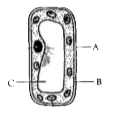Sate four different types of membranes on the basis of permeability
To answer the question "State four different types of membranes on the basis of permeability," we can categorize membranes based on how they allow substances to pass through them. Here’s a step-by-step solution:
Step 1: Define the Types of Membranes
1. Impermeable Membrane: This type of membrane does not allow any substances (neither solutes nor solvents) to pass through.
- Example: The cutinized cell wall, which is found in certain plant cells.
2. Permeable Membrane: This membrane allows both solutes and solvents to pass through freely.
- Example: Cellulosic membranes, which are found in plant cells and allow the movement of both types of molecules.
3. Semi-permeable Membrane: This type of membrane allows only solvent molecules to pass through while preventing solute molecules from passing.
- Example: Egg membranes, which permit the passage of water (solvent) but not larger solute molecules.
4. Selectively Permeable Membrane: This membrane allows only specific solute molecules to pass through while restricting others.
- Example: The tonoplast, which is the membrane surrounding the vacuole in plant cells and selectively allows certain substances to enter or leave the vacuole.
Summary of the Four Types of Membranes:
1. Impermeable Membrane: Does not allow any substances to pass (e.g., cutinized cell wall).
2. Permeable Membrane: Allows both solutes and solvents to pass (e.g., cellulosic membranes).
3. Semi-permeable Membrane: Allows only solvent molecules to pass (e.g., egg membranes).
4. Selectively Permeable Membrane: Allows only specific solute molecules to pass (e.g., tonoplast).
---
1. Impermeable Membrane: This type of membrane does not allow any substances (neither solutes nor solvents) to pass through.
- Example: The cutinized cell wall, which is found in certain plant cells.
- Example: Cellulosic membranes, which are found in plant cells and allow the movement of both types of molecules.
- Example: Egg membranes, which permit the passage of water (solvent) but not larger solute molecules.
- Example: The tonoplast, which is the membrane surrounding the vacuole in plant cells and selectively allows certain substances to enter or leave the vacuole.
1. Impermeable Membrane: Does not allow any substances to pass (e.g., cutinized cell wall).
2. Permeable Membrane: Allows both solutes and solvents to pass (e.g., cellulosic membranes).
3. Semi-permeable Membrane: Allows only solvent molecules to pass (e.g., egg membranes).
4. Selectively Permeable Membrane: Allows only specific solute molecules to pass (e.g., tonoplast).
Topper's Solved these Questions
- SAMPLE QUESTION PAPER 5 BOOK - ICSECHAPTER - SAMPLE QUESTION PAPER 5 EXERCISE - Part - II Section - B
15 Videos
- SAMPLE QUESTION PAPER 5 BOOK - ICSECHAPTER - SAMPLE QUESTION PAPER 5 EXERCISE - Part - II Section - C
11 Videos
- SAMPLE QUESTION PAPER 5 BOOK - ICSECHAPTER - SAMPLE QUESTION PAPER 5 EXERCISE - Part - II Section - C
11 Videos
- SAMPLE QUESTION PAPER 4 BOOK - ICSECHAPTER - SAMPLE QUESTION PAPER 4 EXERCISE - Part - II Section - C
9 Videos
- SEED DORMANCYBOOK - ICSECHAPTER - SEED DORMANCYEXERCISE - REVIEW QUESTIONS (VI Long Answer Type Questions)
10 Videos
Similar Questions
What is the different type of cells on the basis of nuclear material found inside?
View SolutionDescribe different types of neurons on the basis of their functions.
View SolutionDescribe different types of animals on the basis of nature of nitrogenous wastes excreted by them.
View SolutionWhat are four different types of energy losses in a transformer? State how to reduce/minimize any one of them.
View SolutionThe diagram given below shows a few parts of a cell.

State the difference between the parts labelled A and B on the basis of permeability.
View SolutionFollowing graph is obtained for four different reactions
On the basis of above graph, correct increasing order of reaction is
View SolutionWhat are the nephrons ? Describe the types of nephrons on the basis of their location
View SolutionDiffefent types of electromagnetic waves are defined on the basis of
View SolutionThe plasma membrane is more permeable to
View SolutionWhich membrane of chlorolast is more permeable?
View Solution
